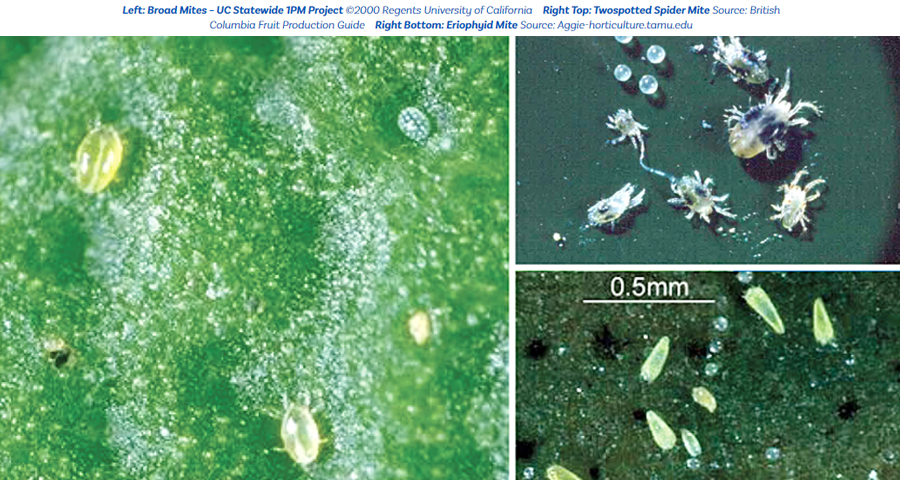Winning the battle against mite populations requires proper scouting, effective weed control, and a toolkit of holistic solutions to avoid pesticide resistance.
In the greenhouse, unchecked mite populations have the potential to grow into a crop-killing crisis. Taking a proactive approach to mite management requires growers to understand mite behavior and life cycles, how to spot pest populations, and the best ways to address the problem without exacerbating it.
Initiating control at the beginning signs of infestation ensures better results. You’ll want to act fast before damage affects the whole season.

Left: Broad Mites – UC Statewide 1PM Project ©2000 Regents University of California Right Top: Twospotted Spider Mite Source: British Columbia Fruit Production Guide Right Bottom: Eriophyid Mite Source: Aggie-horticulture.tamu.edu
Getting Started with Mite Management
Scouts should look for leaf curling and distortion on new growth and discoloration on older leaves, as this can indicate that mites are present. Often confused for a nitrogen deficiency, the discoloration from mite activity will be more bronze than yellow. Mites also tend to be a problem in the winter when dry air from greenhouse heaters creates an ideal climate for reproduction.
Taking an Integrated Pest Management Approach
An integrated approach helps to ensure growers avoid the resistance issues that can occur when one chemical solution is overused.
Greenhouse operations confronting multiple pests take chemical resistance seriously when applying control treatments, especially when
encountering spider mites that reproduce rapidly. Often, pests that reproduce quickly are also likely to be resistant to chemistries because they spawn before the chemicals don’t have a chance to halt life cycles. Using products that target spider mites will help secure the crop.
A well-rounded toolkit of solutions should include:
- Isolating or destroying infested plants and instituting a quarantine period for new plants entering the greenhouse. While two to three weeks is ideal, a minimum of one week will allow any potential mite populations to begin manifesting.
- Using a 0.0075-inch mesh screen (#76 mesh) to help keep mites from getting into the greenhouse.
- Removing plant refuse and eliminating weed populations around the greenhouse. Mites feed on many hosts and can take refuge in these materials. BioSafe Systems’ AXXE® Broad Spectrum Herbicide is an OMRI-Listed option that provides non-selective weed control as well as being labeled for control of soft-bodied insects.
- Rotating in biorational formulations. Early in the season, BioSafe Systems’ AzaGuard®, an OMRI-Listed insect growth regulator can help to disrupt mite life cycles. Horticultural oils, beneficial insects that prey on mites, and other biorational products with multiple modes of action can help traditional and organic growers better manage these pests and avoid resistance.
TOP TIP
Scouting greenhouses for anything unusual is an important tactic for protecting operations. The more detailed the better; record numbers and check the top and bottom of the leaves at least once a week. Using a 20X loupe hand lens is helpful while scouting to spot tiny mites.
TABLE 1. This table gives a basic overview of biocontrol agents that can be used for specific pest mites (Remember: Do not guess, 100% positive ID). There are other beneficials, but these are the most commonly used. Talk to your supplier about the specific rates for your situation.
Source: Suzanne Wainwright-Evans and Greenhouse Grower magazine
FAMILY
Common Name
Scientific Name
Adults ID
Eggs ID
Other Info
Predatory Mites for Management
Insects for Management
TETRANYCHIDAE
Twospotted Spider Mites
Tetranychus urticae
0.4 mm long and oval
Spherical, laid in webbing
Can have different color forms
Phytoseiulus persimilis Amblyseius califomicus Neoseiulus fal/acis
Chrysoperla rufilabris
Feltiella acarisuga
TARSONEMIDAE
Broad Mite
Polyphagotarsonemus latus
0.2 mm long and oval
Elliptical, 0.08 mm,
covered by whitish bumps
Males often carry females
on their backs
Amblyseius cucumeris Amblyseius swirskji
(mixed results in cannabis) Neoseiulus califomicus
ERIOPHYIDAE
Hemp Russet Mites
Aculops cannabicola
Less than 0.3 mm,
spindle-shaped
Spherical and generally
laid in groups
Slow moving
Amblyseius andersoni Amblyseius cucumeris Noseiulus califomicus Neoseiulus fal/acis Amblyseius swirskii
(mixed results in cannabis)


